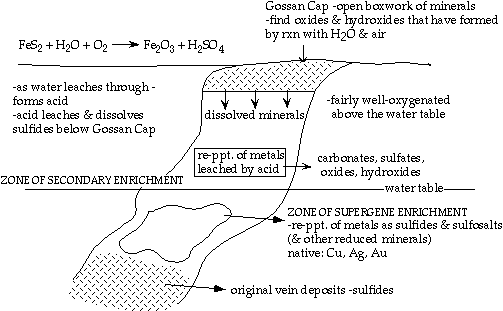Sulfides (& sulfosalts)
Sulfides: major ore minerals on earth - very diverse group
- anions: S, Se, Te, As, Sb, Bi
note that Se, Te, As, Sb, and Bi can also act as cations
=> resulting compound is a sulfosalt
- cations: Fe, Cu, Zn, Ni, Co, Mn
minor: Ag, Cd, Sn, Pt, Hg, Tl, Pb, Bi
- Common occurrences:
- Associated with volcanic activity and hot springs
- ** Hydrothermal vein deposits (may be associated with continental rifting)
Classification system (Lindgren)
3 Types of Hydrothermal Deposits:
- Epithermal deposits:
- Mesothermal deposits:
- moderate temperatures: 200-300oC
- pressure: moderate to high - deeper in crust
- common minerals:
ORES: sulfides of Fe, Pb, Zn, Cu, & gold veins
GANGUE: quartz, calcite, rhodochrosite, siderite
- Hypothermal deposits:
- high temperatures: 300-500oC
- pressure: moderate to high
- common minerals:
ORES: cassiterite (Sn), scheelite & wolframite (W),
GANGUE: quartz, tourmaline, topaz,
other high temp silicates
Supergene Enrichment
*veins undergo a secondary enrichment - become more concentrated in ores

All Pages Copyright © GeoClassroom. All Rights Reserved.
|